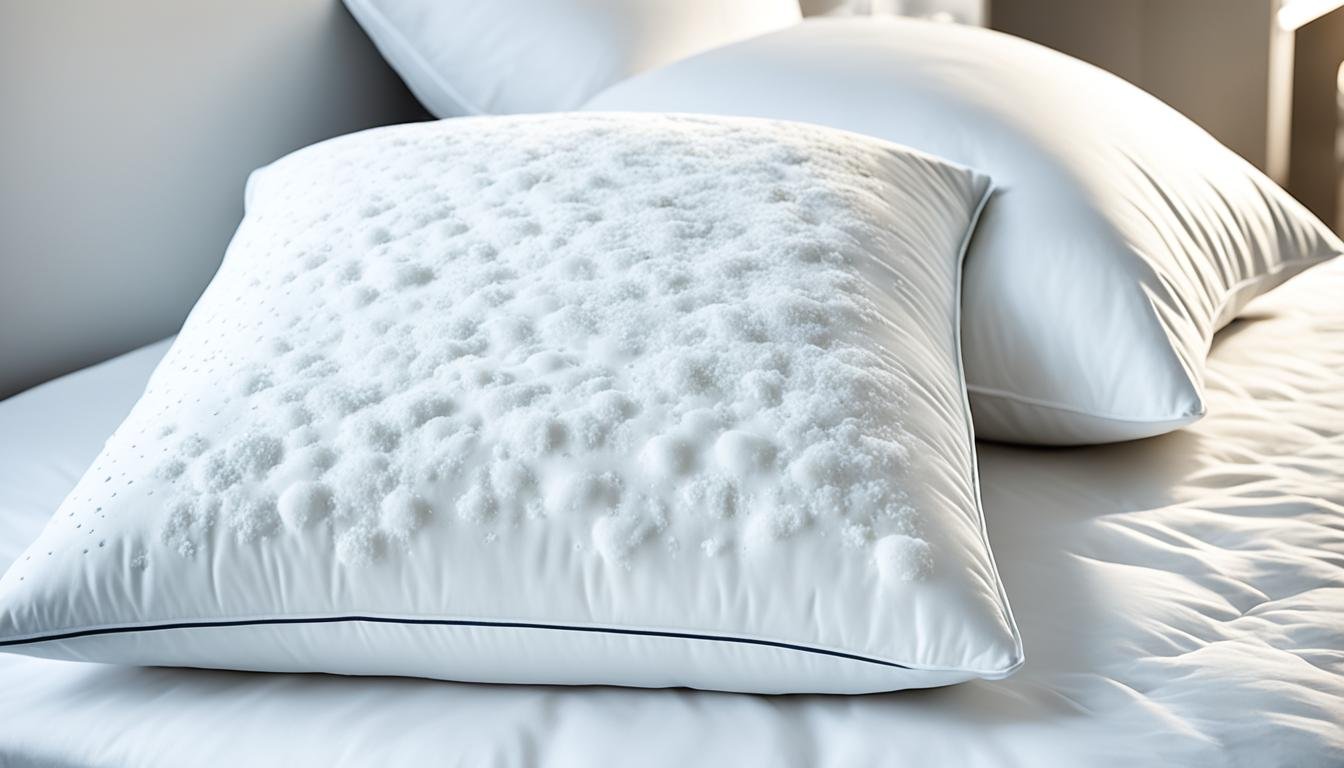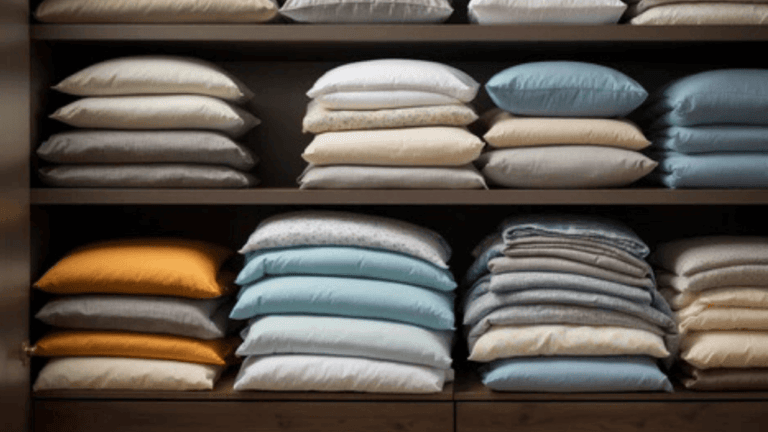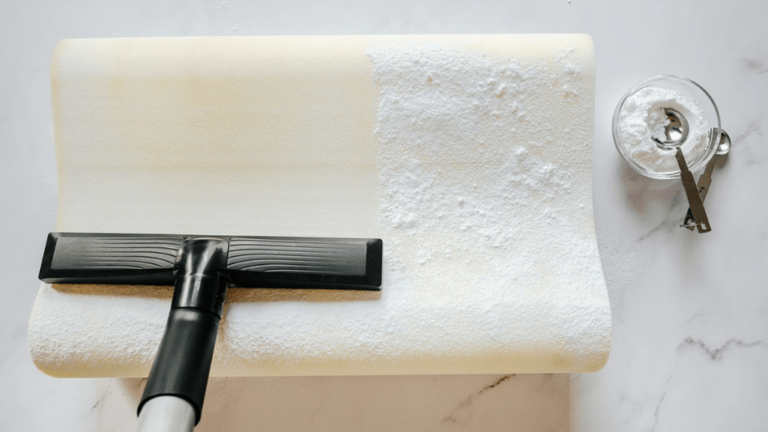Getting good sleep means looking into many things, like your pillow. Not much attention is given to how often we should change our pillows. Yet, this plays a big role in how well we sleep. Many keep using their favorite pillow even when it’s old and flat. But knowing when to get a new one is crucial for our health and good sleep.
Experts say a new pillow means a clean place to rest your head. It also keeps your neck and spine in the right position. This can prevent any discomfort when you wake up. But is there a way to know when it’s time for a new pillow while keeping things affordable? This article will share tips on keeping your pillow in the best shape for a peaceful sleep every night.
Key Takeaways
- How Often to Replace Pillows at the right time is key to good sleep and health.
- Knowing when to get a new pillow can stop sleep troubles and boost health.
- Switching pillows often supports your neck and back as you sleep.
- A new pillow can also reduce allergens and skin cells, making a cleaner sleep area.
- Being aware of when to replace pillows makes your bedding last longer and improves sleep.
The Evolution of Pillows and Their Impact on Sleep Quality
The way we rest our heads has changed a lot since the early days. It’s interesting to look at how pillows have evolved and how they help us sleep better. As we look into the history and importance of pillows, we understand more about restful sleep.
From Stone to Support: A Brief History of Pillows
In the beginning, people used stone and wood for headrests. Over time, softer materials like straw and feathers added comfort. Pillows changed through the ages, becoming both nicer to look at and more comfortable.
- Ancient Egypt: Stone supports aimed at preserving elaborate hairstyles while sleeping.
- China: Ceramics and bamboo pillows, often used to ward off spirits and ensure alignment of the body.
- Roman Empire: Cloth pillows stuffed with materials such as feathers, providing more comfort.
- Modern Era: From synthetic fibers to memory foam, modern pillows cater to ergonomics and allergies.
Why Your Sleep Depends on Your Pillow
Pillows are very important for good sleep. They support your neck and spine for pain-free rest. Modern pillow designs consider different sleeping positions and needs, thanks to ongoing research.
- Support: Proper elevation for neck and head, crucial for spinal health.
- Comfort: Materials like memory foam adapting to individual shapes, reducing pressure points.
- Health: Hypoallergenic and antimicrobial pillows ensuring a cleaner sleep environment.
Pillows have come a long way in providing comfort at night. They have transformed from simple designs to advanced ones, showing how we constantly strive for better sleep.
Recognizing When to Change a Pillow
Knowing when to change a pillow is key for good sleep and health. Pillows get old and show wear over time. Looking for signs of an aged pillow tells you when it’s time for a new one. This is important for comfort, neck and spine alignment, and pillow hygiene.
Identifying the Signs of an Aged Pillow
Old pillows can lose support, causing sleep issues. Signs of aging include lumpiness, discoloration, and not bouncing back to shape. If you wake up sore, your pillow may be the culprit. Check your pillow often to decide if it’s time for a change.
The Role of Pillows in Neck and Spine Alignment
The right pillow keeps your neck and spine lined up while you sleep. The wrong pillow can hurt your posture and cause neck and spinal problems. A good pillow keeps your head in a natural spot, like when you are standing.
The ‘Ick’ Factor: What Accumulates in Your Pillow Over Time
Pillows can gather things like skin cells, dust mites, body oils, and sweat over time. This can mess with the pillow’s structure and cause hygiene issues. If your pillow seems dirty, it’s likely time for a new one. Keeping your sleep space clean is a must.
Understanding Pillow Lifespan
Getting a good night’s sleep isn’t just about the mattress. Your pillow is crucial too. But pillows don’t last forever. Knowing your pillow lifespan helps keep your sleep healthy. Let’s look at what impacts when you need a new pillow and the factors affecting pillow longevity.
How Often Should You Replace Your Pillow?
The rule is to get a new pillow every 1 to 2 years. Experts agree on this timeline. It’s vital for both comfort and cleanliness. Pillows can collect dust mites, skin cells, and oils. These can trigger allergies and lower a pillow’s quality.
Factors Affecting Pillow Longevity
Different things affect how long your pillow lasts. The material, how you use it, and where you live matter. Cleaning and airing out your pillow helps it stay in good shape for longer. But if you don’t take care of it, it won’t last as long.
Here’s how to keep your pillow longer:
- Shielding it with a protective cover to limit exposure to sweat and oils
- Fluffing it daily to maintain its shape and comfort
- Ensuring proper cleaning according to the manufacturer’s instructions
- Replacing it promptly when you notice signs of wear or a decrease in support
Knowing when to get a new pillow is key to preventing bad sleep. Look out for signs like a flat pillow, smells, or neck pain in the morning. These are clues that your pillow isn’t helping your sleep anymore.
Finally, paying attention to what impacts pillow life helps you make smart choices. A new, supportive pillow means better sleep and health.
Pillow Care Tips for Extending Lifespan
If you want your pillows to last longer and stay comfy, it’s key to know how to care for them. Taking care of your pillows does not just make them last longer. It also makes your sleep better. Here, we’ll talk about how to maintain and wash different types of pillows.
Maintenance Strategies for Different Pillow Types
We need to look at how different pillows need different care:
- Feather Pillows: It’s good to air them out regularly. This removes moisture and keeps them fluffy. Using a pillow protector also helps protect against oils and dead skin.
- Foam Pillows: Air these out now and then and give them a gentle tap to keep shapes right. But, don’t bend them; it might break the foam inside.
- Synthetic Pillows: Fluff these pillows every day to keep them nice and puffy. Also, rotate them so they wear out evenly.
For all pillow types, avoid putting them in direct sunlight. This can stop the materials from breaking down and help pillows last longer.
Washing Routines for Feather, Foam, and Synthetic Pillows
Cleaning pillows right is crucial. Each kind needs a different approach:
- Feather Pillows: You can machine wash these on a gentle cycle. Washing two at a time keeps the machine balanced. Make sure they are completely dry to avoid mildew.
- Foam Pillows: These don’t do well in washing machines. Spot clean them using mild detergent and let them air dry well.
- Synthetic Pillows: You can wash these in a machine with warm water. Use gentle detergent. Then, tumble dry on low with tennis balls to fluff them back up.
Always check the care label from the maker before washing your pillows. This gives you the specific cleaning steps for your pillow.
Decoding the Best Time to Get a New Pillow
Understanding the best time to get a new pillow is crucial for better sleep. Not everyone will need a new pillow at the same time. Signs like discomfort or a drop in sleep quality suggest it’s time to change.
Experts recommend a schedule for replacing pillows. This can be 1 to 2 years, based on how you use it and the pillow type. Listen to your body’s signals to know when it’s time for a new one.
- Lifespan of Your Current Pillow: Reflect on when you last replaced your pillow. If it’s been over 18 months, it’s likely time for a new one.
- Visible Signs of Wear: Notice any lumps, sagging, or discoloration? These are clear signals that your pillow is past its prime.
- Waking Up with Allergies: An increase in allergic reactions upon waking might indicate allergens have accumulated in your pillow.
When finding the optimal pillow replacement period, consider your sleep habits and hygiene. People with allergies might need to change their pillows more often to avoid dust mites and allergens.
Follow these tips for a better sleeping environment. Update your pillow as needed to improve your sleep quality. This practice is key to getting restful sleep every night.
How to Maintain a Pillow Replacement Frequency

It’s key to have a pillow replacement frequency for restful sleep every night. This habit not only keeps things clean but also helps your pillows last longer. They’ll give the proper support for your neck and spine. Let’s explore setting up a pillow maintenance schedule and spotting when to replace a pillow.
Creating a Pillow Maintenance Schedule
Starting a maintenance routine is simple. Think about your pillow type, how often you use it, and what you prefer. Usually, changing pillows every 1-2 years ensures the best sleep.
- Analyze the types of pillows you own and their specific care instructions.
- Track their usage to help gauge wear and tear over time.
- Set calendar reminders for cleaning and check-up dates.
Following these steps makes maintaining pillow replacement frequency easy.
Signs It’s Time to Replace a Pillow
Watch for clear signs to replace a pillow. Knowing when it’s time for a new one is crucial.
- Lumps or unevenness affecting the pillow’s surface.
- Persistent discomfort or neck pain upon waking.
- Noticeable stains or odors even after washing.
- Exacerbation of allergies, which could be attributed to dust mite accumulation.
Monitoring these indicators helps maintain sleep quality by avoiding old bedding.
Choosing the Right Pillow: Materials and Longevity
Finding the perfect pillow means looking at pillow materials and pillow longevity. The type of pillow you choose affects its life, health impact, and when you’ll need a new one. When you match your pillow to your needs, your sleep and health improve.
The Durability of Different Pillow Types
Durability is key when picking out a pillow. You have many choices, from soft feather and down to sturdy memory foam and latex. Feather pillows feel plush but might not keep their shape as long as foam or latex.
Memory foam pillows support well and last long if you take good care of them. Latex pillows are strong and supportive, lasting longer than many others.
- Feather & Down: Luxurious softness but may require more frequent replacement.
- Memory Foam: Excellent support and durability with proper care.
- Latex: Resistant to wear, holding shape over time.
Hypoallergenic and Antimicrobial Options for Allergy Sufferers
Don’t let allergies ruin your sleep. Hypoallergenic pillow options help reduce allergic reactions. They’re made from materials like cotton and bamboo or special synthetic fills. Antimicrobial pillows stop bacteria and mold, helping reduce allergies further. This is vital for those sensitive to indoor allergens, ensuring sleep isn’t disturbed by sneezing or itching.
- Hypoallergenic Cotton or Bamboo: Natural fibers treated to reduce allergens.
- Antimicrobial Synthetic Fills: Engineered to resist bacteria and mold growth.
In summary, choosing the right pillow involves weighing materials for comfort and health, and understanding how different fills affect longevity. The right choice, be it durable latex, soft down, or hypoallergenic options, leads to better sleep and brighter mornings.
Pillow Replacement: Investing in Quality Sleep
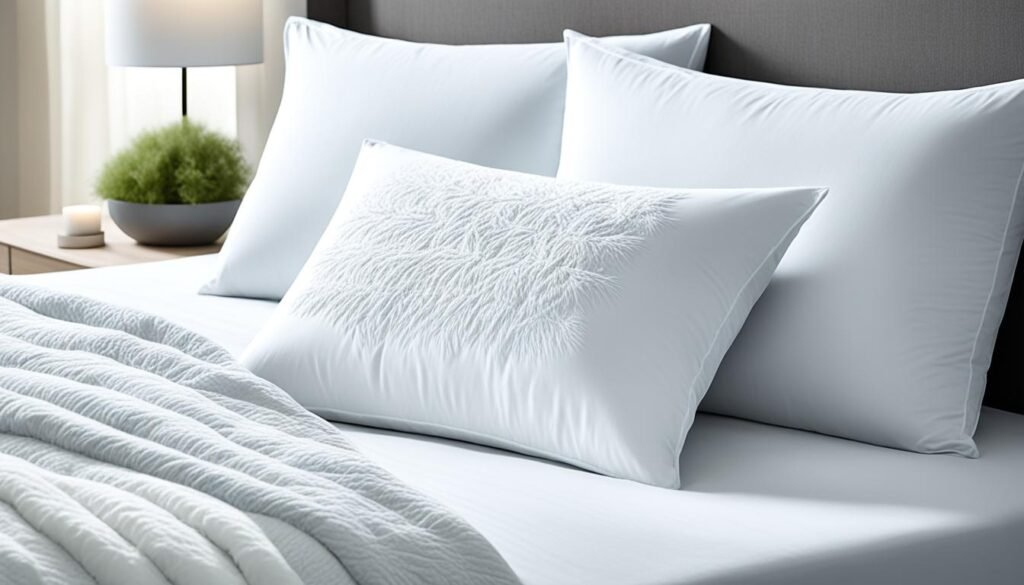
Investing in good sleep isn’t just about getting fancy bedding or the latest sleep gadgets. Often, it’s simpler things that make a big difference, such as pillow replacement. A new pillow is key for quality sleep. It shows you care about your health and well-being. Let’s explore why changing your pillows regularly is a smart move for your sleep.
By getting a new pillow often, you’re looking after your health. A fresh pillow keeps your neck and spine aligned. This means you wake up feeling good, not sore or stiff from old pillows. A good pillow helps you sleep deeply, which is vital for your body to heal and work well.
- Alleviation of allergens that can disrupt sleep and cause health issues
- Enhanced comfort and support leading to improved sleep patterns
- Prevention of skin irritations and breakouts due to cleaner sleeping surfaces
Think of investing in sleep as investing in yourself. Better sleep affects your mood, how much you get done, and your health in the long run. Starting with your pillow, good sleep habits are easy but can change your life.
- Examine your current pillow: Is it supporting you as it should?
- Think about the last time you replaced your pillow: Have you exceeded the recommended two-year period?
- Reflect on your sleep quality: Could it improve with a simple pillow replacement?
Making timely pillow changes shows you’re taking charge of your sleep. When quality sleep is a priority, each night is a chance to refresh. Investing in good pillows is a small but important step to a healthier, more energetic life.
The Ongoing Investigation of Pillow Science
In our journey through pillow science, it’s clear how much our sleep benefits from it. The impact on sleep health from expert analysis is changing our views. It unveils the link between sleep aids and our well-being.
Emerging Sleep Trends and Pillow Innovations
The world of sleep is always evolving. New sleep trends are popping up as both scientists and people look for better rest. Pillows are changing too, with new materials and designs. They meet diverse needs and bring us closer to the dream of perfect sleep.
Expert Analysis on Pillow Replacement and Sleep Health
Expert analysis highlights how changing pillows on time benefits sleep health. Old pillows aren’t just uncomfortable. They harbor allergens and mess with your back. They suggest choosing pillows that support your neck and are good for allergies. This can change the way we sleep for the better.
Conclusion
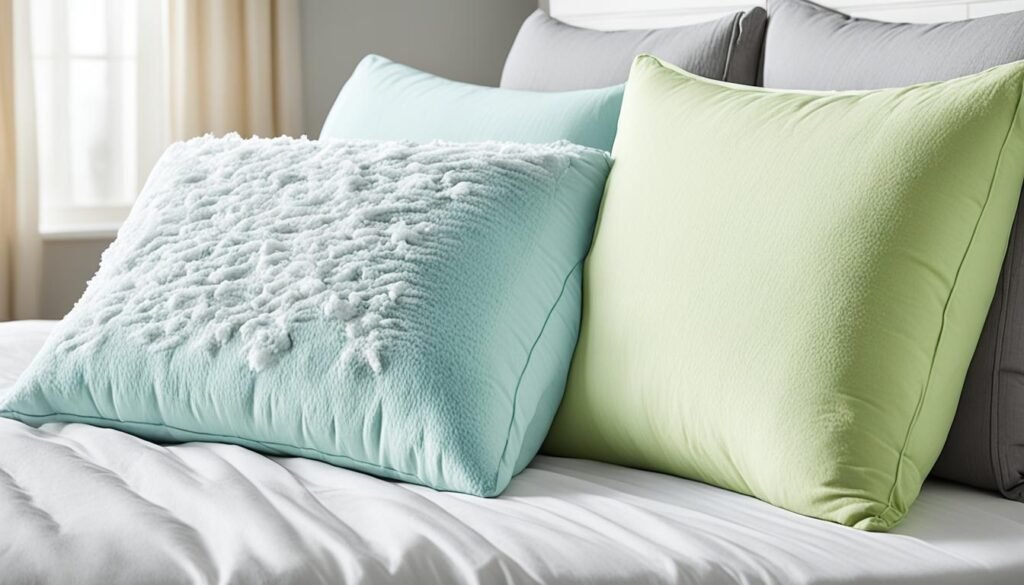
As we end our detailed talk on good sleep habits, our final thoughts focus on the need to change pillows regularly. This article has given you the knowledge on why keeping your pillow clean matters. It’s not just for comfort but also for your health and sleep quality.
Our summary points out the importance of noticing when your pillow is old and worn out. A new, supportive pillow can really improve your sleep. Following these tips will help you sleep better each night, which is great for your overall health.
- Identifying signs of wear and the appropriate timeline for pillow replacement
- Understanding how pillow materials and care affect longevity
- Adopting practical tips for extending pillow lifespan
- Recognizing the role of new pillows in enhancing sleep quality
In conclusion, changing your pillows regularly is very important. It’s a key part of good sleep hygiene. Making this change ensures you have a restful and healthy sleep every night. Sleep well, knowing that a fresh pillow is crucial for a peaceful night.
Frequently Asked Questions
Wondering when to replace your pillow is a big step towards better sleep. Let’s clear up the frequently asked questions about this topic. It’s not just about what you prefer; it’s also about keeping your sleep clean and comfy. Here we aim to clear up common questions about pillow replacement, so you can enjoy refreshing sleep without any doubts.
The first big question is how to know when your pillow’s no good anymore. Look out for lumps or if it stops giving the support you need. Sometimes, if you start sneezing more because of dust mites and allergens, it’s also a hint. Another big point people wonder about is what materials last longer. Down feathers feel great but don’t last as long as the man-made stuff because they break down faster.
Many also worry about how to keep their pillows in good shape longer. Cleaning them regularly and picking the right one for how you sleep helps a lot. We hope this article answers your questions and helps you focus on getting good sleep by knowing when it’s time for a new pillow.

